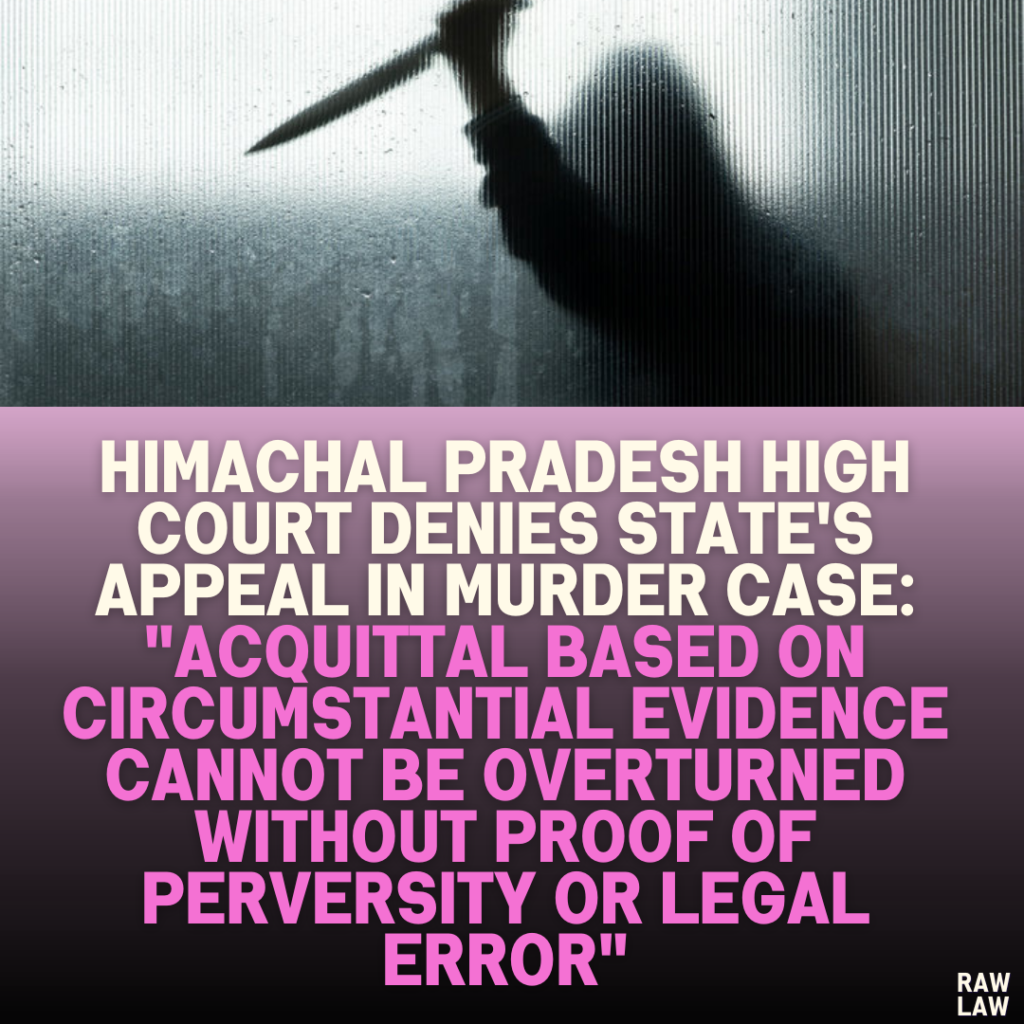Court’s Decision
The Himachal Pradesh High Court dismissed the State’s application seeking leave to appeal against the acquittal of the accused. The court concluded that the trial court’s judgment, which acquitted the accused in a murder case based on circumstantial evidence, was reasonable and did not warrant interference. The appellate court emphasized that a plausible view taken by the trial court, even if another view is possible, cannot be overturned unless it is found perverse or erroneous in law.
Facts
- Incident Details:
The deceased’s body was found naked in a water tank on 3rd June 2014. Injuries and strangulation marks were observed on the body. The accused, the husband of the deceased, identified the body. - Investigation:
- Witnesses reported seeing injuries and branches of a tree covering the body in the tank.
- Police recovered several items, including an iron pipe, blood-stained clothing, threads, buttons, and burnt pieces of a saree.
- DNA analysis did not conclusively link the accused to the deceased.
- The accused claimed he had reported his wife as missing.
- Prosecution’s Stand:
The prosecution alleged that the accused murdered his wife due to suspicions about her fidelity and tried to cover up the crime. Circumstantial evidence, including recoveries, DNA evidence, and call data records, was presented to support their case. - Trial Court Verdict:
The trial court found that the prosecution failed to establish a conclusive chain of circumstances linking the accused to the crime. The accused was acquitted of charges under Sections 302 and 201 of the Indian Penal Code.
Issues
- Was the circumstantial evidence presented by the prosecution sufficient to establish guilt beyond reasonable doubt?
- Did the trial court err in acquitting the accused based on the evidence?
Petitioner’s Arguments (State):
The State argued:
- The circumstantial evidence, when viewed collectively, pointed to the accused’s guilt.
- The accused was present near the crime scene, which was corroborated by call data records.
- Items such as a blood-stained shirt and burnt pieces of saree recovered at the instance of the accused further implicated him.
- The trial court failed to properly appreciate evidence, particularly witness testimonies and forensic reports.
Respondent’s Arguments (Accused):
The accused:
- Denied all allegations and claimed innocence.
- Asserted that he was falsely implicated based on assumptions rather than concrete evidence.
- Highlighted that recoveries and circumstantial evidence did not directly link him to the crime.
Analysis of the Law
- Presumption of Innocence:
The court highlighted the principle of presumption of innocence, which strengthens upon acquittal by the trial court. This presumption requires a higher threshold of evidence to reverse an acquittal. - Appeal Against Acquittal:
Relying on Mallappa v. State of Karnataka and Sanjeev v. State of Himachal Pradesh, the court reiterated that an appellate court must only interfere with an acquittal if the trial court’s findings are perverse, erroneous, or contrary to evidence. - Admissibility of Evidence:
- The court emphasized that confessions made to police officers or during custody are inadmissible under Sections 25 and 26 of the Indian Evidence Act, unless they lead to discovery of facts as per Section 27.
- Recoveries made from public places or places accessible to others are unreliable and cannot alone establish guilt.
Precedent Analysis
The court referred to several cases to underline the principles applicable to circumstantial evidence and recoveries:
- Manjunath v. State of Karnataka: Recovery from public places lacks evidentiary value.
- State of Maharashtra v. Damu: A confession or statement leading to recovery is inadmissible if no new facts are discovered.
- Amin v. State: Delayed recoveries by investigating officers are suspect.
Court’s Reasoning
- Circumstantial Evidence:
The prosecution’s case relied entirely on circumstantial evidence. However, the court found significant gaps in the evidence, including:- DNA analysis failed to link the blood on the accused’s shirt to the deceased.
- The iron pipe recovered at the instance of the accused was not proven to be connected to the injuries.
- Burnt pieces of saree were found in an open area accessible to the public, reducing their probative value.
- Witness Testimonies:
- The testimony of key witnesses was inconsistent. For instance, some witnesses stated the body was discovered due to routine checks, not at the accused’s instance.
- The deceased’s daughter, who could have testified about the relationship between the accused and the deceased, was not examined.
- Recovery and Admissibility:
The recoveries made at the instance of the accused were not hidden or uniquely linked to the crime. Therefore, they lacked evidentiary weight. - Call Data Records:
The court reasoned that the accused’s presence near the water tank was explained by his search for his missing wife and did not conclusively indicate guilt.
Conclusion
The Himachal Pradesh High Court upheld the trial court’s acquittal, ruling that:
- The prosecution failed to establish an unbroken chain of circumstances leading to the accused’s guilt.
- The trial court’s decision was a plausible interpretation of the evidence, warranting no interference.
- The leave to appeal was denied, and the acquittal stood.
Implications
This case reinforces the principle that in circumstantial evidence-based prosecutions:
- Each link in the chain must be conclusively proven.
- Recoveries and confessions must strictly adhere to evidentiary requirements.
- Acquittals should not be overturned unless the findings are manifestly illegal or perverse.
The judgment serves as a reminder of the high standards of proof required in criminal trials and the importance of procedural safeguards to ensure justice.



